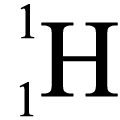Isotopes
Key Idea 2: Defining Isotopes
What is the difference between two atoms that have the same number of protons but different numbers of neutrons
What Do We Know?
The number of protons in an atom's nucleus determines the identity of an atom and the atomic number (Z). The number of protons plus the number of neutrons is defined as an atom's mass number which is given the symbol A.
In nature, all atoms of an element have the same atomic number, but they do not necessarily have the same mass number. Changing the number of neutrons in an atom's nucleus changes the mass of the atom without altering its identity as an element. Atoms of the same element that have different numbers of neutrons in their nucleus are known as isotopes. An element may have several stable isotopes, only one, or none at all. Because different isotopes have slightly different masses, the substances whose molecules have different isotopes exhibit small differences in physical and chemical behaviour.

In words, isotopes are described with the element name followed by the mass number: for example, hydrogen-1 (one proton; no neutrons) or carbon-12 (six protons; six neutrons). Also, isotopes are commonly depicted in symbolic form (as shown below and right).
The symbolic convention for describing isotopes displays the atom's mass number (A) and atomic number (Z) beside the element symbol (in this case, X). When these symbols are used, the atomic number may be omitted because the symbol of the element (X) defines the number of protons within the atom.

